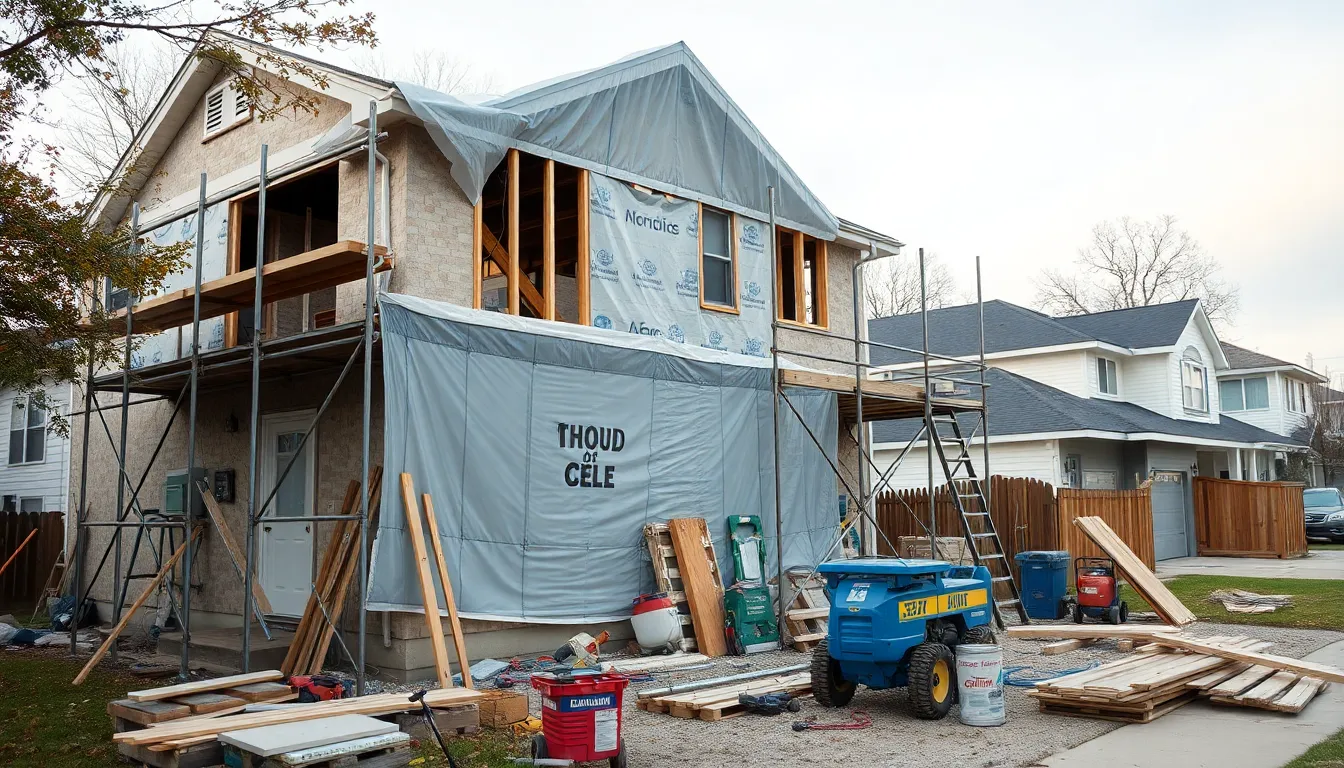Table of Contents
ToggleHome improvement projects can turn a drab space into a dream oasis, but they can also lead to unexpected surprises—like discovering your walls are more “Swiss cheese” than solid. That’s where home improvement insurance swoops in like a superhero, ready to save the day and your wallet. Whether it’s a leaky roof or a wayward sledgehammer, having the right coverage means you can tackle renovations with confidence instead of dread.
Imagine transforming your living room without worrying about what happens if your DIY project goes awry. Home improvement insurance offers peace of mind, protecting you from the financial fallout of mishaps. It’s like having a safety net while you juggle paint cans and power tools. So before diving headfirst into that Pinterest-inspired renovation, let’s explore why home improvement insurance is the unsung hero of every homeowner’s toolkit.
What Is Home Improvement Insurance?
Home improvement insurance offers coverage for homeowners engaged in renovation projects. This type of insurance protects against financial losses stemming from unexpected issues such as structural problems, accidents, and damages that may arise during construction. Coverage typically includes general liability and property damage, ensuring that homeowners minimize risks associated with their projects.
Many homeowners undertake renovations without realizing the potential pitfalls. For instance, accidents can occur on-site, leading to injuries or equipment damage. Home improvement insurance addresses these risks, providing a safety net that allows for smoother project execution.
In addition, certain policies may cover theft of tools or materials, an important consideration for many DIY enthusiasts. These inclusions help ensure that homeowners do not face overwhelming costs due to unforeseen circumstances.
It’s essential to obtain quotes from different insurers to find the right policy that meets specific renovation needs. Factors like project scope, location, and budget can influence premium costs. Therefore, thorough research aids homeowners in selecting coverage that aligns with their unique situations.
Home improvement insurance empowers homeowners with the confidence to proceed with renovations. As they embark on their projects, knowing that potential mishaps are covered fosters a more worry-free experience. Prioritizing this form of insurance equips homeowners with vital financial protection, making it a critical component of any renovation plan.
Types of Home Improvement Insurance

Various types of home improvement insurance exist to protect homeowners during renovation projects. Understanding each type ensures homeowners select the right coverage for their specific needs.
General Liability Insurance
General liability insurance offers protection against accidents and injuries that may occur on a homeowner’s property during renovations. This coverage typically includes costs related to property damage and medical expenses for injured parties. Homeowners can mitigate financial risks associated with contractors or workers causing injuries. Coverage often extends to legal fees if a lawsuit arises. It’s essential for homeowners hiring contractors to confirm they have general liability insurance in place, safeguarding against potential liabilities during the project.
Builders Risk Insurance
Builders risk insurance provides coverage for homes undergoing construction or renovation. This type of policy protects against damage caused by risks like fire, theft, or vandalism during the project. It typically covers materials, fixtures, and equipment on-site. Homeowners should consider obtaining builders risk insurance when undertaking significant renovations or new constructions. Depending on the policy, additional coverage for tools and equipment might also be available. This insurance helps homeowners avoid significant out-of-pocket expenses if unexpected damage occurs during their renovation journey.
Importance of Home Improvement Insurance
Home improvement insurance plays a critical role for homeowners during renovation projects. Such insurance provides essential coverage for unexpected issues.
Financial Protection
Financial protection against renovation-related problems is a primary benefit of home improvement insurance. Homeowners face risks like damage due to accidents or theft of tools during projects. Without adequate coverage, these costs could lead to significant financial strain. Home improvement policies cover both materials and labor, ensuring that if something goes wrong, such as water damage or fire, homeowners maintain their financial security. Many policies offer options for customization, allowing homeowners to select coverage that fits their specific projects and budgets. Homeowners can confidently manage their renovation plans, knowing insurance helps mitigate unexpected expenses.
Legal Requirements
Legal requirements for home improvement insurance vary by state and project scope. Some homeowners may need proof of insurance before commencing significant renovations. Local laws often mandate liability coverage to protect against potential injuries on-site. Contractors typically carry general liability insurance, but homeowners should verify this coverage for further comfort. Non-compliance with legal insurance requirements might result in fines or halted projects. Hence, understanding regional regulations empowers homeowners to navigate legal landscapes effectively. Having home improvement insurance not only safeguards physical property but also aligns with necessary legal frameworks, streamlining renovation processes.
How to Choose the Right Policy
Selecting the right home improvement insurance policy requires careful consideration of individual needs and available options. Homeowners face numerous factors that influence coverage choices.
Assessing Your Needs
Identify specific project scopes to determine appropriate coverage. Include considerations such as the renovation size, location, and total budget. Evaluate potential risks associated with each project type, including accidents, theft, or property damage. Homeowners often benefit from understanding their personal tolerance for risk, as this may guide their coverage levels. Addressing unique needs leads to a more tailored insurance solution, ensuring financial protection during renovations.
Comparing Providers
Obtain quotes from multiple insurance providers to explore all options. Each provider may offer distinct coverage features and policy limits. Analyze differences in premiums to identify the best value for money. Investigate customer reviews and industry ratings to assess provider reliability. Understand claims handling processes, as responsive customer service can make a significant difference during stressful situations. Conducting thorough comparisons empowers homeowners to make informed decisions, enhancing their renovation confidence.
Home improvement insurance is an invaluable asset for any homeowner embarking on renovation projects. It provides essential financial protection against the unexpected challenges that can arise during renovations. By understanding the types of coverage available and tailoring policies to fit specific needs, homeowners can confidently manage their projects.
Taking the time to compare quotes and assess risks ensures that homeowners choose the right coverage for their unique situations. This proactive approach not only safeguards their investments but also enhances peace of mind throughout the renovation process. With the right home improvement insurance in place, homeowners can focus on transforming their spaces without the worry of potential setbacks.





